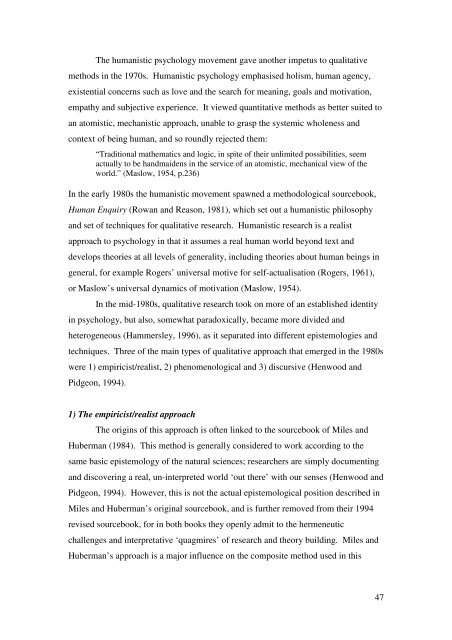DEVELOPMENTAL CRISIS IN EARLY ADULTHOOD: A ...
DEVELOPMENTAL CRISIS IN EARLY ADULTHOOD: A ...
DEVELOPMENTAL CRISIS IN EARLY ADULTHOOD: A ...
Create successful ePaper yourself
Turn your PDF publications into a flip-book with our unique Google optimized e-Paper software.
The humanistic psychology movement gave another impetus to qualitative<br />
methods in the 1970s. Humanistic psychology emphasised holism, human agency,<br />
existential concerns such as love and the search for meaning, goals and motivation,<br />
empathy and subjective experience. It viewed quantitative methods as better suited to<br />
an atomistic, mechanistic approach, unable to grasp the systemic wholeness and<br />
context of being human, and so roundly rejected them:<br />
“Traditional mathematics and logic, in spite of their unlimited possibilities, seem<br />
actually to be handmaidens in the service of an atomistic, mechanical view of the<br />
world.” (Maslow, 1954, p.236)<br />
In the early 1980s the humanistic movement spawned a methodological sourcebook,<br />
Human Enquiry (Rowan and Reason, 1981), which set out a humanistic philosophy<br />
and set of techniques for qualitative research. Humanistic research is a realist<br />
approach to psychology in that it assumes a real human world beyond text and<br />
develops theories at all levels of generality, including theories about human beings in<br />
general, for example Rogers’ universal motive for self-actualisation (Rogers, 1961),<br />
or Maslow’s universal dynamics of motivation (Maslow, 1954).<br />
In the mid-1980s, qualitative research took on more of an established identity<br />
in psychology, but also, somewhat paradoxically, became more divided and<br />
heterogeneous (Hammersley, 1996), as it separated into different epistemologies and<br />
techniques. Three of the main types of qualitative approach that emerged in the 1980s<br />
were 1) empiricist/realist, 2) phenomenological and 3) discursive (Henwood and<br />
Pidgeon, 1994).<br />
1) The empiricist/realist approach<br />
The origins of this approach is often linked to the sourcebook of Miles and<br />
Huberman (1984). This method is generally considered to work according to the<br />
same basic epistemology of the natural sciences; researchers are simply documenting<br />
and discovering a real, un-interpreted world ‘out there’ with our senses (Henwood and<br />
Pidgeon, 1994). However, this is not the actual epistemological position described in<br />
Miles and Huberman’s original sourcebook, and is further removed from their 1994<br />
revised sourcebook, for in both books they openly admit to the hermeneutic<br />
challenges and interpretative ‘quagmires’ of research and theory building. Miles and<br />
Huberman’s approach is a major influence on the composite method used in this<br />
47
















